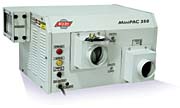While the seriousness of mold problems continues to be debated, there is no question that airborne pathogens and other forms of bacteria have created enormous problems for many schools. Some students come down with illnesses or rashes that cause buildings to shut down until solutions are put in place.
In order to be proactive (the best plan) and provide their students with the best possible environment, schools can look into the use of desiccant dehumidification in conjunction with the conventional HVAC system.
Sick Schools
Children get sick all the time. But what if the school building is making them sick?Mel Meyers, president of Bry-Air, Sunbury, Ohio, said that many buildings across the country have what is known as Sick Building Syndrome (SBS). This includes school buildings.
Meyers said that according to American Society of Heating, Refrigerating and Air-Conditioning Engineers (ASHRAE) Standard 62 recommendations, school buildings must provide 15 cfm per student to avoid most indoor air quality (IAQ) issues.
“Back in the 70s, no one worried about [IAQ],” he said. And before that, “Buildings weren’t built very tight.” Meyers said those buildings were getting the adequate amount of outdoor air circulating through the building. All of this changed in the 1970s during the oil embargo and the energy crisis. Buildings were built with energy efficiency in mind. To do this, Meyers said, structures were built tight to conserve energy.
Turns out it wasn’t just heat that stayed in the building. “You end up with a lot of pollutants in the air,” explained Meyers.

Common Misconceptions
Meyers explained that today, schools have some misconceptions when it comes to controlling mold and bacteria.Some schools set back the A/C system, keeping the building at a higher temperature during summer months to conserve energy. What school officials don’t understand is that keeping the unoccupied building at a higher temperature allows relative humidity to rise, giving mold and fungi the moisture they need to survive and breed.
Some schools reduce their ventilation rates because of the performance limitations of conventional HVAC systems. In this case, students don’t receive the amount of fresh air cited in Standard 62. According to Meyers, the best way to control humidity and provide students with the appropriate amount of fresh air is to install a desiccant dehumidifier in-line with the conventional system, and control temperature and humidity separately.
For the past six months, Bry-Air has met with schools and school architects to discuss the importance of installing a dehumidification system. The meetings focus on educating these people on why mold becomes active, the critical need for constant humidity control, the importance of proper ventilation to student heath, and how desiccant dehumidification works.
Even more importantly, the manufacturer has been informing school officials that dehumidification does not have to break the school system’s budget.
Independent Operation
The company has provided dehumidification equipment for a number of applications. For example, Meyers said that the MiniPac unit has been ideal for restaurants and libraries.He explained that dehumidification is extremely beneficial for libraries because old books are a perfect place for mold spores to bloom and breed. After seeing the positive effects dehumidification can have with libraries, Meyers said Bry-Air decided to turn its attention to schools and their libraries, where mold has been developing into a serious situation.
According to Meyers, controlling the humidity levels in a space works best when the dehumidification unit works independently of the HVAC system, regardless of the temperature. Bry-Air’s newest desiccant dehumidification unit, the MiniPac, can do just that.
Meyers explained that the unit is an add-on appliance that connects into the school’s existing A/C system. The unit is much like a window air conditioner, he said, and has its own humidistat control. This allows school staff to control the humidity independent of the temperature. Meyers said this is an important function; using a thermostat to control humidity is one of the main causes for poor humidity control in air conditioned buildings, he said.
For example, after students and teachers leave for the day and the air conditioning system shuts off, a traditional dehumidification system that works along with the HVAC system will shut down as well. The MiniPac will continue to monitor and control relative humidity levels.
In addition, the company offers larger sizes of desiccant dehumidifiers to accommodate other school areas. Smaller models could be installed to dehumidify a classroom or a library, for example, while a larger model (the BryPac) may be needed for larger areas or the entire facility.
Meyers said that MiniPac not only allows better humidity control, it is also more in line with a typical school’s budget. He said that the redesign of an HVAC system can cost approximately $30,000 or more. A MiniPac will set the school back $4,000 to $8,000.
The company has already met with school officials and architects in Ohio to discuss the MiniPac and the importance of controlling humidity and temperature separately with desiccant dehumidification.
“The reception has been really good,” Meyers said. “And the benefits are very clear. When you correctly dehumidify, you reduce the chance of exposing yourself to significant lawsuits and you may not have to shut your building down. Most important, the occupants will be comfortable and have a healthy environment.”
Publication date: 08/11/2003








